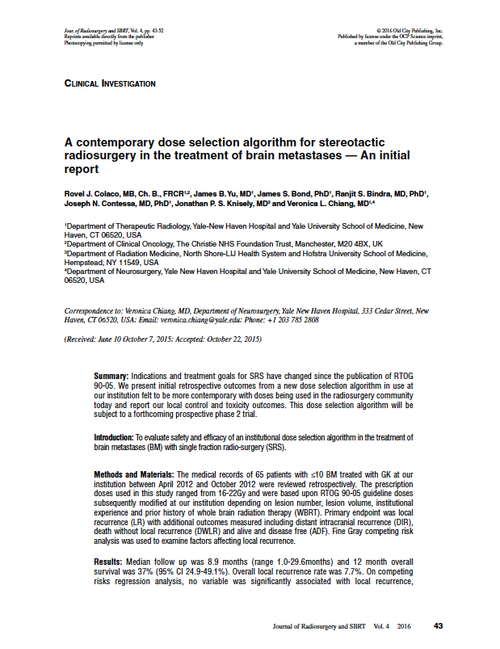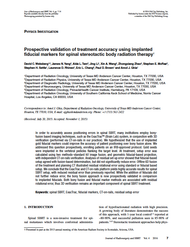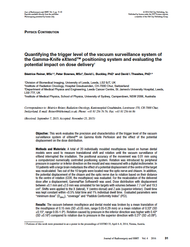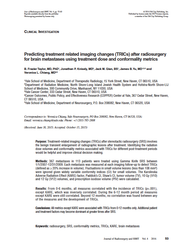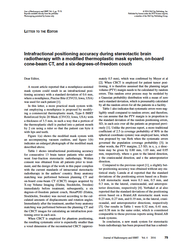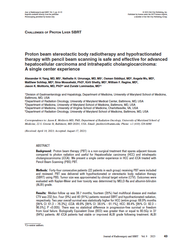- Home
- Journal Contents Downloads
- JRSBRT Downloads
- JRSBRT 4.1, p. 43-52
Product Description
A contemporary dose selection algorithm for stereotactic radiosurgery in the treatment of brain metastases — An initial report
Rovel J. Colaco, James B. Yu, James S. Bond, Ranjit S. Bindra, Joseph N. Contessa, Jonathan P. S. Knisely and Veronica L. Chiang
Summary: Indications and treatment goals for SRS have changed since the publication of RTOG 90-05. We present initial retrospective outcomes from a new dose selection algorithm in use at our institution felt to be more contemporary with doses being used in the radiosurgery community today and report our local control and toxicity outcomes. This dose selection algorithm will be subject to a forthcoming prospective phase 2 trial.
Introduction: To evaluate safety and efficacy of an institutional dose selection algorithm in the treatment of brain metastases (BM) with single fraction radio-surgery (SRS).
Methods and Materials: The medical records of 65 patients with ≤10 BM treated with GK at our institution between April 2012 and October 2012 were reviewed retrospectively. The prescription doses used in this study ranged from 16-22Gy and were based upon RTOG 90-05 guideline doses subsequently modified at our institution depending on lesion number, lesion volume, institutional experience and prior history of whole brain radiation therapy (WBRT). Primary endpoint was local recurrence (LR) with additional outcomes measured including distant intracranial recurrence (DIR), death without local recurrence (DWLR) and alive and disease free (ADF). Fine Gray competing risk analysis was used to examine factors affecting local recurrence.
Results: Median follow up was 8.9 months (range 1.0-29.6months) and 12 month overall survival was 37% (95% CI 24.9-49.1%). Overall local recurrence rate was 7.7%. On competing risks regression analysis, no variable was significantly associated with local recurrence, plan including previous whole brain radiotherapy (WBRT), (SHR 1.21 [95%CI 0.13-11.5], p=0.87 and radioresistant versus radiosensitive histology (SHR 0.51 [95% CI 0.06-7.73], p=0.55). No patient developed grade 3 or higher neurotoxicity at 12 months following GK.
Conclusions: Initial local control and toxicity results from our institutional dose selection algorithm are reported here. Comparison of our results with RTOG 90-05 is difficult due to significant differences in the patient population and their treatments. The applicability of this algorithm merits further investigation across multiple centers for the purpose of treatment and clinical trial standardization in single fraction SRS and will be the subject of a forthcoming phase 2 prospective study within our own institution.
Keywords: brain metastases, dose selection, stereotactic radiosurgery, gamma knife
 Loading... Please wait...
Loading... Please wait...

